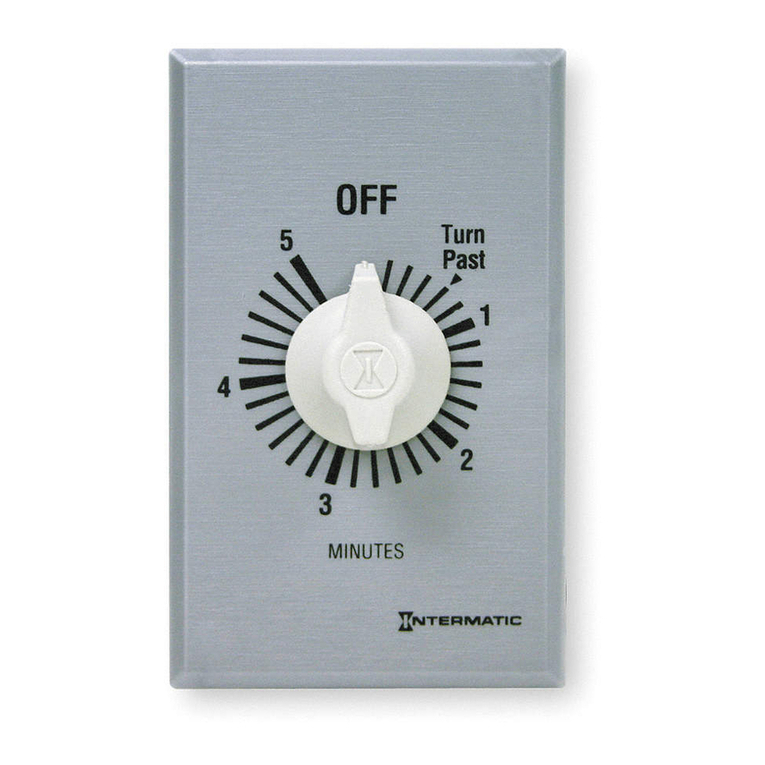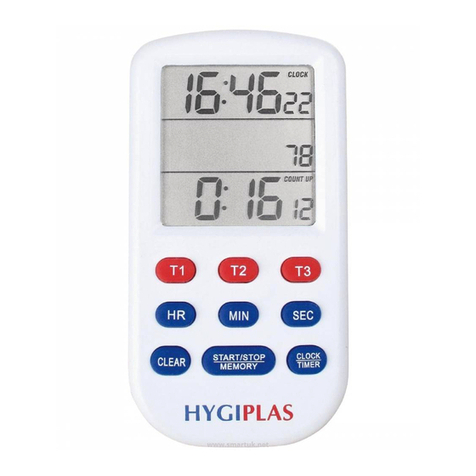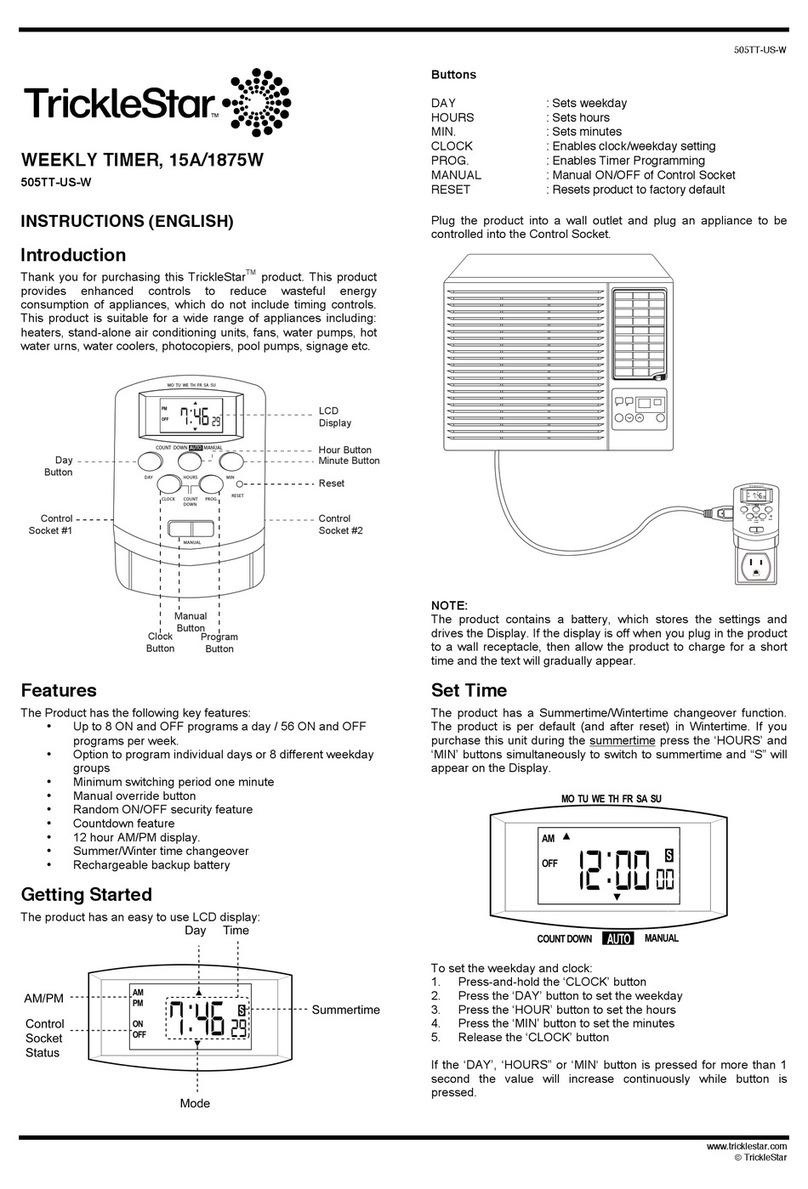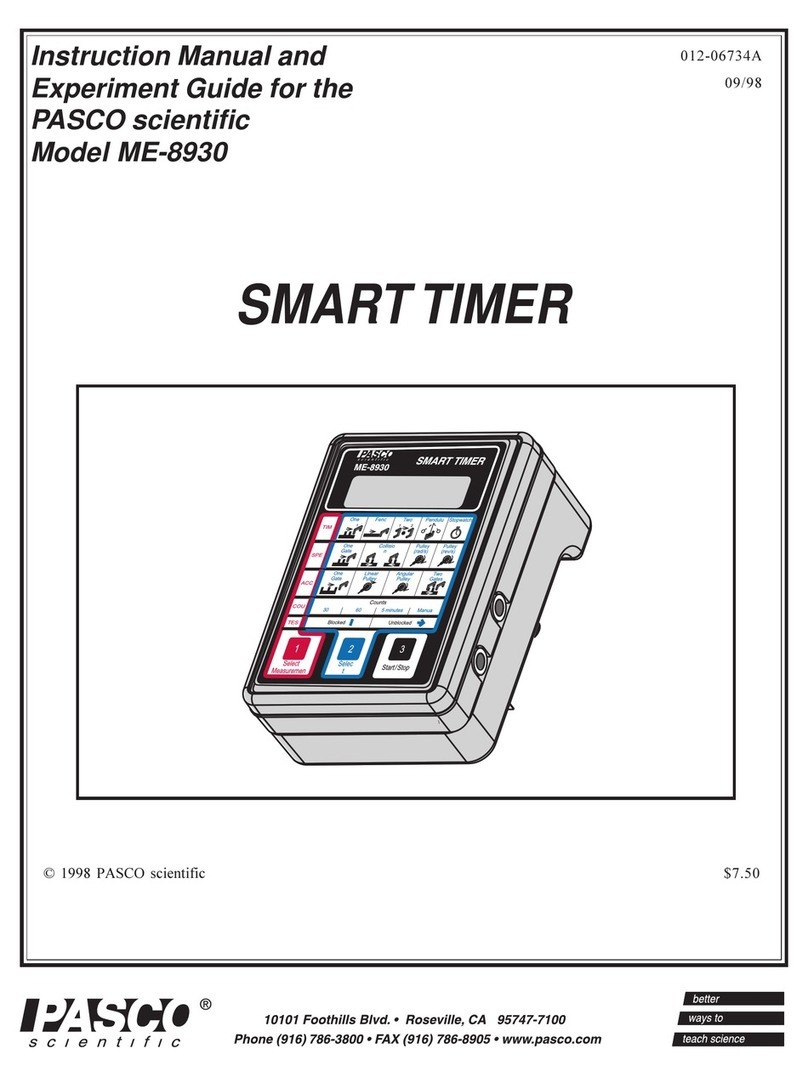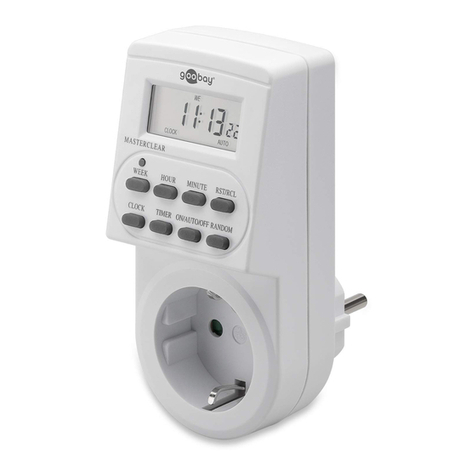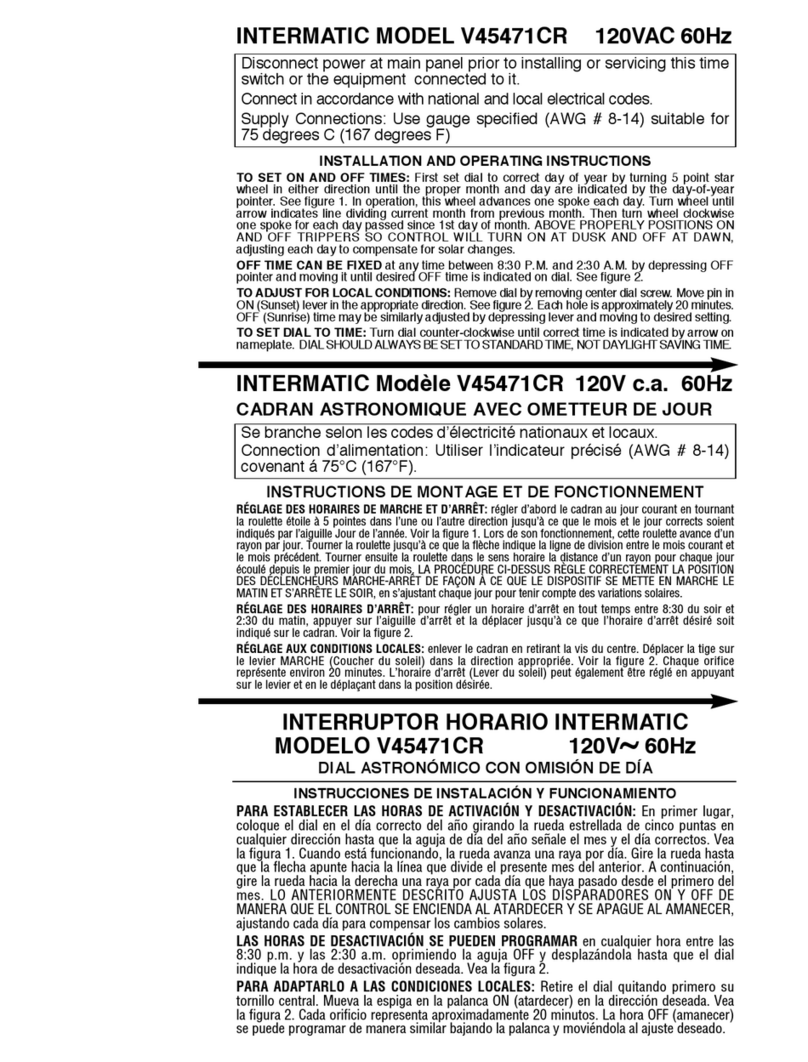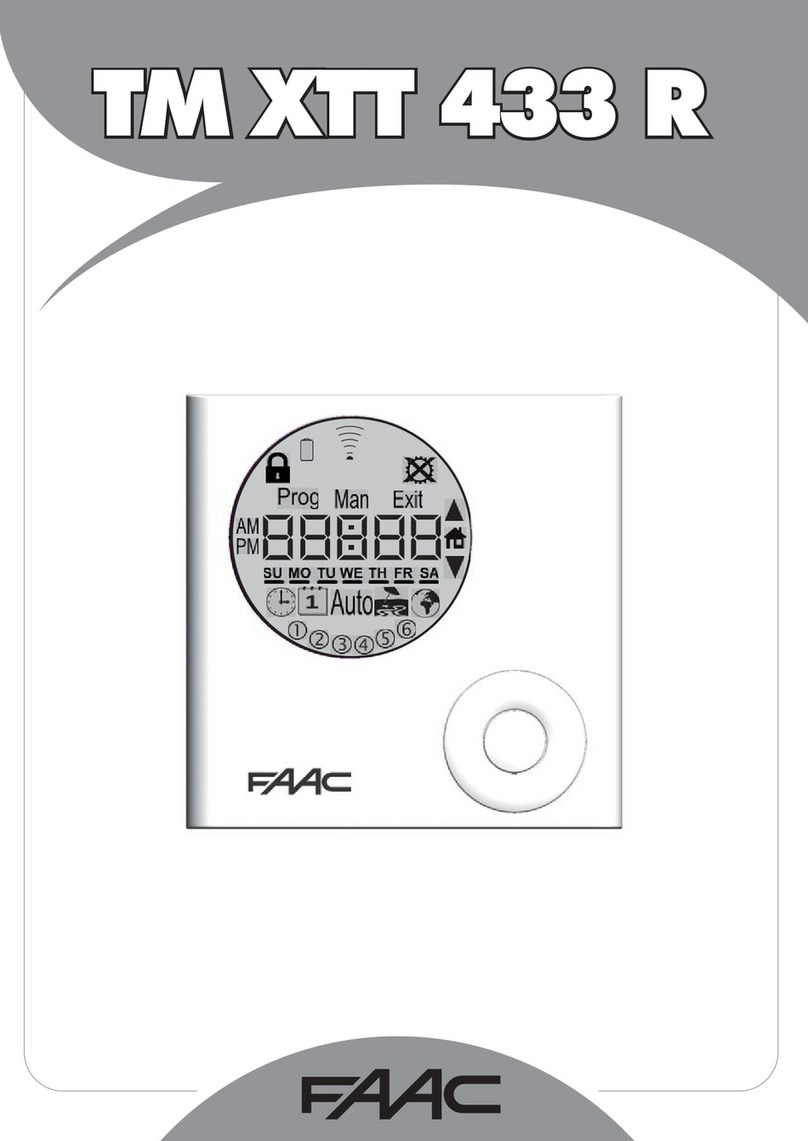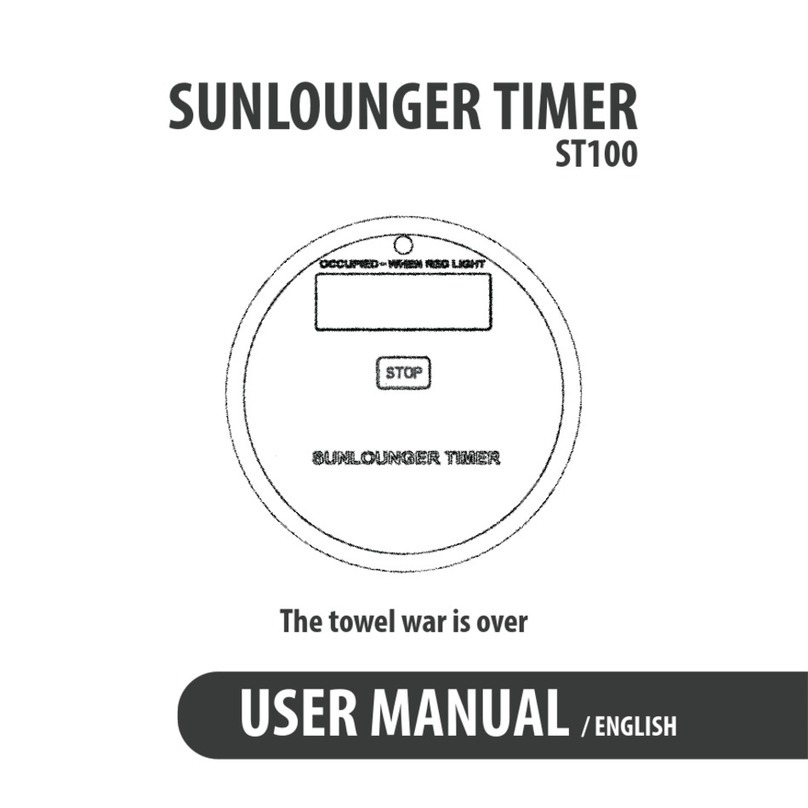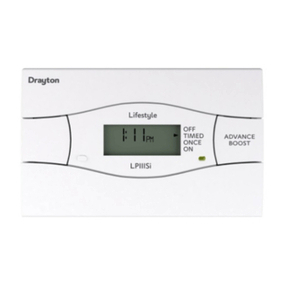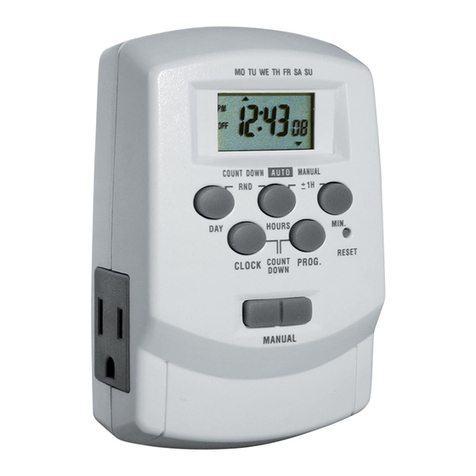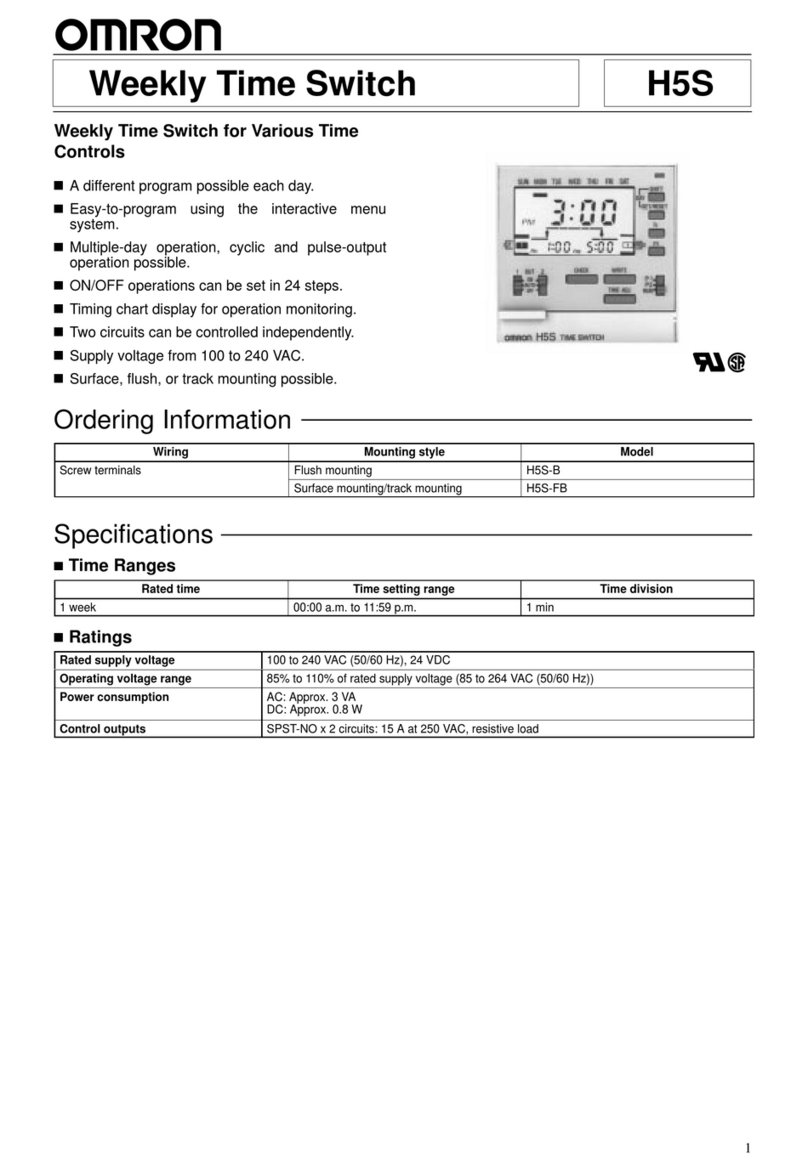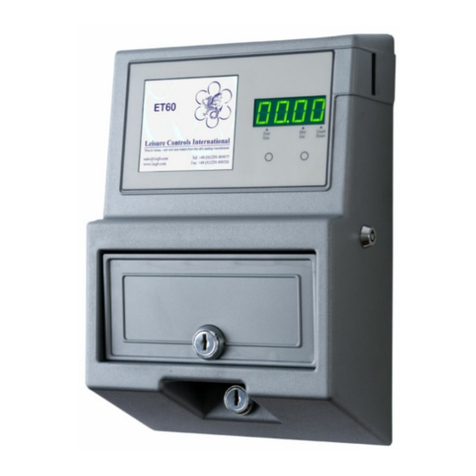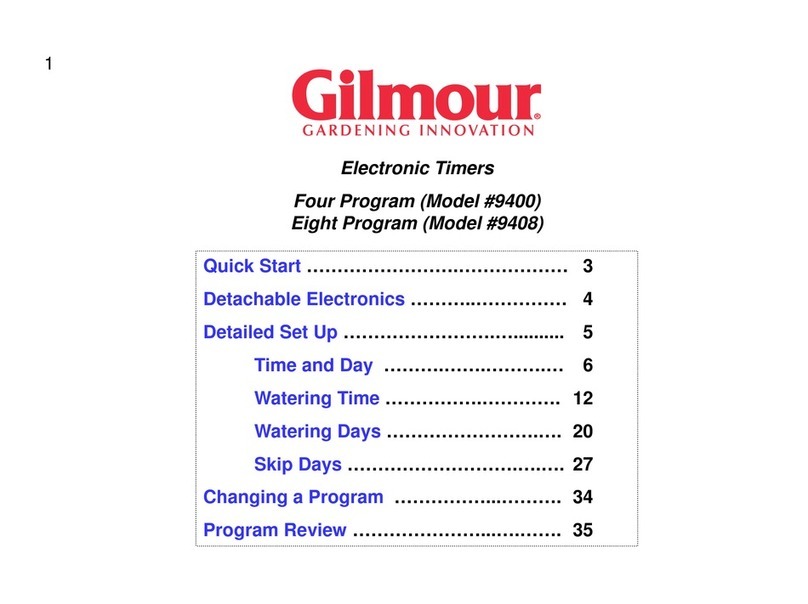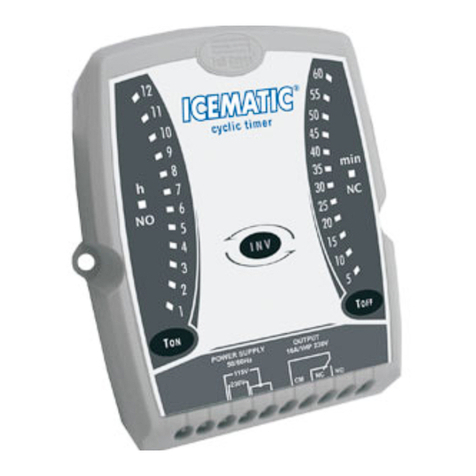ORTEC 996 Service manual

Model 996
Timer and Counter
Operating and Service Manual
Printed in U.S.A. ORTEC®Part No. 736820 1202
Manual Revision F

Advanced Measurement Technology, Inc.
a/k/a/ ORTEC®, a subsidiary of AMETEK®, Inc.
WARRANTY
ORTEC* warrants that the items will be delivered free from defects in material or workmanship. ORTEC makes
no other warranties, express or implied, and specifically NO WARRANTY OF MERCHANTABILITY OR
FITNESS FOR A PARTICULAR PURPOSE.
ORTEC’s exclusive liability is limited to repairing or replacing at ORTEC’s option, items found by ORTEC to
be defective in workmanship or materials within one year from the date of delivery. ORTEC’s liability on any
claim of any kind, including negligence, loss, or damages arising out of, connected with, or from the performance
or breach thereof, or from the manufacture, sale, delivery, resale, repair, or use of any item or services covered
by this agreement or purchase order, shall in no case exceed the price allocable to the item or service furnished
or any part thereof that gives rise to the claim. In the event ORTEC fails to manufacture or deliver items called
for in this agreement or purchaseorder, ORTEC’s exclusiveliabilityandbuyer’s exclusiveremedy shallbe release
of the buyer from the obligation to pay the purchase price. In no event shall ORTEC be liable for special or
consequential damages. Quality Control
Before being approved for shipment, each ORTEC instrument must pass a stringent set of quality control tests
designed to expose any flaws in materials or workmanship. Permanent records of these tests are maintained for
use in warranty repair and as a source of statistical information for design improvements.
Repair Service
If it becomes necessary to return this instrument for repair, it is essential that Customer Services be contacted in
advance of its return so that a Return Authorization Number can be assigned to the unit. Also, ORTEC must be
informed, either in writing, by telephone [(865) 482-4411] or by facsimile transmission [(865) 483-2133], of the
nature of the fault of the instrument being returned and of the model, serial, and revision ("Rev" on rear panel)
numbers. Failure to do so may cause unnecessary delays in getting the unit repaired. The ORTEC standard
procedure requires that instruments returned for repair pass the same quality control tests that are used for
new-production instruments. Instruments that are returned should be packed so that they will withstand normal
transit handling and must be shipped PREPAID via Air Parcel Post or United Parcel Service to the designated
ORTEC repair center. The address label and the package should include the Return Authorization Number
assigned. Instruments being returned that are damaged in transit due to inadequate packing will berepaired at the
sender's expense, and it will be the sender's responsibility to make claim with the shipper. Instruments not in
warranty should follow the same procedure and ORTEC will provide a quotation.
Damage in Transit
Shipments should be examined immediately upon receipt for evidenceof externalor concealeddamage. Thecarrier
making deliveryshouldbenotifiedimmediatelyofanysuchdamage, sincethecarrier is normallyliable for damage
in shipment. Packing materials, waybills, and other such documentation should be preserved in order to establish
claims. After such notification to the carrier, please notify ORTEC of the circumstances so that assistancecan be
provided in making damage claims and in providing replacement equipment, if necessary.
Copyright © 2002, Advanced Measurement Technology, Inc. All rights reserved.
*ORTEC®is a registered trademark of Advanced Measurement Technology, Inc. All other trademarks used
herein are the property of their respective owners.

iii
CONTENTS
WARRANTY ....................................................................... ii
SAFETY INSTRUCTIONS AND SYMBOLS ............................................... v
SAFETY WARNINGS AND CLEANING INSTRUCTIONS ..................................... vi
1. DESCRIPTION................................................................... 1
1.1. GENERAL .................................................................. 1
2. SPECIFICATIONS ................................................................ 2
2.1. PERFORMANCE ............................................................. 2
2.2. INDICATORS................................................................ 2
2.3. CONTROLSDISPLAY......................................................... 3
2.4. INPUTS .................................................................... 4
2.5. OUTPUTS .................................................................. 4
2.6. INTERFACES ............................................................... 4
2.7. ELECTRICALANDMECHANICAL................................................ 4
2.8. ORDERINGINFORMATION .................................................... 5
3. INSTALLATION .................................................................. 5
3.1. INPUTPOLARITYSELECTION.................................................. 5
3.2. COUNTERINPUTSELECTJUMPER ............................................. 6
3.3. GENERAL .................................................................. 6
3.4. CONNECTIONTOPOWER..................................................... 6
3.5. SIGNALCONNECTIONS....................................................... 6
3.6. OUTPUTCONNECTIONS...................................................... 7
3.7. PRESET TIME OPERATION .................................................... 7
3.8. PRESET COUNT OPERATION .................................................. 7
4. OPERATING INSTRUCTIONS ....................................................... 8
4.1. RS-232-C INTERFACE (MODEL 99X-1) ........................................... 8
4.1.1. 20-mA CURRENT LOOP OUTPUT .......................................... 9
4.1.2. USINGTHE99X-1WITHAPRINTER........................................ 9
4.1.3. INSTALLATION INSTRUCTIONS .......................................... 10
4.2. IEEE-488 (GPIB) INTERFACE (MODEL 99X-2) ..................................... 10
4.2.1. USINGTHE99X-2WITHAPRINTER....................................... 12
4.2.2. INSTALLATION INSTRUCTIONS .......................................... 12
4.3. PRINTLOOPINTERFACE(MODEL99X-3) ....................................... 13
4.3.1. INSTALLATION INSTRUCTIONS .......................................... 14
5. PROGRAMMINGTHE996......................................................... 15
5.1. RS-232-C INTERFACE ....................................................... 15
5.1.1. TERMINALOPERATION ................................................ 15
5.1.2. BASIC PROGRAMMING ................................................. 16
5.2. INTERFACING TO THE IEEE-488 BUS ........................................... 17
5.2.1. HEWLETT-PACKARDCOMPUTEREXAMPLES .............................. 18
5.2.2. IBM-PCPROGRAMMINGEXAMPLES ...................................... 22
APPENDIX A. ASCII COMMANDS TO THE MODULE ...................................... 27
A.1. COMMANDWORDS......................................................... 27
A.2. DATAVALUES ............................................................. 27

iv
A.3. CHECKSUMS .............................................................. 27
A.4. RESPONSE FROM THE MODULE .............................................. 27
A.5. TIMEUNITSUSEDINCOMMANDS............................................. 27
A.6. CATALOGOFCOMMANDSFORTHE996 ....................................... 27
APPENDIX B. RESPONSE RECORDS FROM THE 996 MODULE ............................ 31
B.1. DELIMITINGCHARACTERS................................................... 31
B.2. PERCENT RESPONSE RECORDS .............................................. 31
B.3. DOLLAR RESPONSE RECORDS ............................................... 32
APPENDIX C. OPTIONAL PARTS LIST ................................................. 33
C.1. CABLESANDCONNECTORS ................................................. 33
C.2. ORDERINGINFORMATION ................................................... 33

v
SAFETY INSTRUCTIONS AND SYMBOLS
This manual contains up to three levels of safety instructions that must be observed in order to avoid
personal injury and/or damage to equipment or other property. These are:
DANGER Indicates a hazard that could result in death or serious bodily harm if the safety instruction
is not observed.
WARNING Indicates a hazard that could result in bodily harm if the safety instruction is not observed.
CAUTION Indicates a hazard that could result in property damage if the safety instruction is not
observed.
Please read all safety instructions carefully and make sure you understand them fully before attempting to
use this product.
In addition, the following symbol may appear on the product:
ATTENTION–Refer to Manual
DANGER–High Voltage
Please read all safety instructions carefully and make sure you understand them fully before attempting to
use this product.

vi
DANGER Opening the cover of this instrument is likely to expose dangerous voltages. Disconnect the
instrument from all voltage sources while it is being opened.
WARNING Using this instrument in a manner not specified by the manufacturer may impair the
protection provided by the instrument.
CAUTION To prevent moisture inside of the instrument during external cleaning, use only enough liquid
to dampen the cloth or applicator.
SAFETY WARNINGS AND CLEANING INSTRUCTIONS
Cleaning Instructions
To clean the instrument exterior:
!
Unplug the instrument from the ac power supply.
!
Remove loose dust on the outside of the instrument with a lint-free cloth.
!
Remove remaining dirt with a lint-free cloth dampened in a general-purpose detergent and water
solution. Do not use abrasive cleaners.
!
Allow the instrument to dry completely before reconnecting it to the power source.

vii
This instrument may have been manufactured with round LED indicators
instead of triangular shaped ones as shown.

1
ORTEC MODEL 996
TIMER AND COUNTER
1. DESCRIPTION
1.1. GENERAL
The ORTEC Model 996 Timer and Counter
incorporates a 100-MHz, 8-decade counter and a
blind preset timer. The basic model offers visual
readout via an 8-decade LED display. By plugging
in field-installable options, considerably enhanced
readout and control capability can be added at any
time.
For automated counting applications not requiring
computer interfacing, the standard ORTEC print
loop function is available as a field-installable plug-
in board. In conjunction with an ORTEC Model
777A Printer, this option offers automatic recycling
of the counting and printing of all 8 digits of the
counter'scontents,along withthat of other counters
in the print loop. In place of the 777A, the ORTEC
Model 879 Buffered Interface can be utilized with
the print loop. This solution provides IEEE-488 and
RS-232-C interfaces for all the counters in the print
loop. The Model 879 has the capability,through the
print loop, to start and stop counting, reset, and
read the contents of the counter in the Model 996
along with other counters in the print loop.
The full power of CCNIM™ (Computer Controlled
NIM) is obtainable by adding the IEEE-488 option
or the RS-232-C option. These plug-in boards yield
computer control of all functions normally
selectable from the front panel, including start and
stop count, readout, reset, setting the preset value,
displaying the preset value, displaying the counter
contents, and selecting the desired time base. To
eliminate accidental operator interference, the
computer can disable all front-panel controls in the
remote mode. Computer readout with either of the
two CCNIM™ options includes the contents of the
counter, the preset value, and the current display
mode.The IEEE-488optionalsoreadstheoverflow
status for the counter. Implementationof the IEEE-
488 interface in the Model 996 is compatible with
the NIM/GPIB standard.1The CCNIM options can
directly drive printers having RS-232-C or IEEE-
488 ports.
Excellent flexibility in setting the preset value is
offered by the MN X 10Pselection. The M and N
values provide two-digit precision, while P selects
the decade. Presetscan be chosen in the rangesof
0.01 to 990,000 seconds, 0.01 to 990,000 minutes,
or 1 to 99,000,000 counts. In the external (EXT)
time base mode, the 996 becomes a displayed,
preset counter. The 996 can function as a
displayed, preset timer by changing the position of
a circuit board jumper and using the 0.01-SEC or
0.01-MIN time base.
Both positive and negative sensing inputs to the
counter are available on the front panel. The
negative input is designed to accept standard NIM
fast-negative logic pulses with a fixed threshold of
-250 mV on a 50-
S
input impedance. The negative
input can handle counting ratesupto 100 MHz. The
positive input can accept counting rates up to 25
MHz on a 1000-
S
input impedance. To enhance
the flexibility of the positive input, a precision
discriminator is included. The discriminator
threshold is variable over the range of +100 mV to
+9.5 V using a front-panel, 25-turn trimpot. The
threshold can be adjusted to suit the amplitude of a
specific source of logic pulses or used as a
precision integral discriminator on analog pulses.
For the latter application the TTL logic output of the
discriminator is providedas a test point on the front
panel. This output can be used to trigger an
oscilloscope while viewing the analog signal at the
counter input on the oscilloscope. The oscilloscope
tracewillshowthesignalsthatare beingcountedby
the Model 996, thus permitting a very selective
adjustment of the threshold.
1See: "STANDARD NIM DIGITAL BUS (NIM/GPIS)", DOE/ER-
0173, U.S. NIM committee, August 1983; "IEEE Standard Digital
Interface for Programmable Instrumentation", ANSI/IEEE Std
488-1978, The Institute of Electrical and Electronics Engineers,
345 East 47 Street, New York, NY 10017; and "Codes and
Format Conventions for Use with ANSI/IEEE Std 488-1978",
ANSI/IEEE Std 728-1982, The Institute of Electrical and
Electronics Engineers, 345 East 47 Street, New York, NY 10017.

2
All the commonly used functions are conveniently
accessible on the front panel. Manual control of the
COUNT STOP, and RESET functions is via three
push buttons. The GATE LED is illuminated when
the Model 996 is enabled to count. Selection of the
0.01-s, 0.01-min, or external time base is made by
the TIME BASE push button. In the external mode
the preset counter countsthe events from the front-
panel positive or negative inputs. The DISPLAY
push button switches the display to show the
contents of the counter or the presetstop value. To
change the preset value, the PRESET mode must
first be selected with the DISPLAY push button.
Subsequently,thePRESETSELECTpushbuttonis
usedtochooseM, N, or P for adjustment.Changing
the value of M, N, or P is accomplished with the
PRESET ADVANCE push button. The display
contains LED flags to indicate whether M, N, or P
has been selected, to warn when an overflow has
occurred in the counter, and to advise when the
front-panel controls aredisabled by the computer in
the remote mode.
When the Model 996 is used without a plug-in
option, jumpers on the circuit board can select
automatic recycling of the counting interval with a
display dwell time of either 1 or 10 s at the end of
each counting interval. The plug-in options disable
the dwell/automatic recyclefunction, when enabled
by an external controller.
The counting function of the entire module can be
disabled by holding the GATE input below +1.5 V
using an external signal source. This condition also
turns off the GATE LED. Open circuit or greater
than +3 V at the GATE input allows the instrument
to count if the COUNT mode has been activated.
TheINTERVALoutputofanotherORTECtimercan
perform this function to synchronize the Model 996
counting with the other timer. The INTERVAL
outputs on all ORTEC timers provide nominally +5
V when counting and less than +0.5 V when
counting is inhibited. Interface connectors for the
plug-in IEEE-488, RS-232-C, and print loopoptions
are located on the rear panel. The overflow output
for the counter is also located on the rear panel.
Counting these overflows on another counter
effectively extends the counting capacity of the
Model 996.
The Model 996 derives its power from the ±12 V,
and +6 V supplies in a standardNIM bin with power
supply.
2. SPECIFICATIONS
2.1. PERFORMANCE
COUNT CAPACITY 8 decades for counts ranging
from 0 to 99,999,999.
MAXIMUM COUNTING RATE 100 MHz for
negative input; 25 MHz for positive input.
TIMEBASE 10-MHz clock with minimum preset or
displayed intervals of 0.01 s or 0.01 min.
Synchronizing error is nominally 100 ns. Also
accepts an external input from the counter input
when the EXT (external) mode is selected.
TIME BASE ACCURACY Within ±0.0025% over
the 0-50° C operating temperature range.
PRESET TIME/COUNTS The module stops
counting when the preset value MN X 10Pis
reached on the blind preset register. M and N are
digits ranging from 0 to 9. P is a digit ranging from
0 to 6. With the 0.01-SEC time base, preset times
from 0.01 to 990,000 s can be used. Preset times
from 0.01 to 990,000 min are available using the
0.01-MIN time base. In the EXT time base mode,
preset counts in the range of 1 to 99,000,000 can
be used.
POSITIVE INPUT DISCRIMINATOR Threshold
variable from +100 mV to +9.5 V with a 25-turn
trimpot.
PULSE PAIR RESOLUTION <10 ns for negative
input; <40 ns for positive input.
2.2. INDICATORS
COUNTER DISPLAY 8-digit, 7-segment LED
display with leading zero suppression. When
displaying time, two digits to the right of a decimal
point are included.
OVERFLOW INDICATOR An LED indicator
labeled OVF illuminateswhen the counter exceeds
its capacity of 8 decades. The indicator remains on
until a reset is generated.

3
M, N, AND P INDICATORS Three LED indicators
aid in the selection of the preset value. When the
PRESET display function is activated, the SEL
(select) push button will select which of the three
LEDsisilluminated. When one of theseLEDsison,
that digit of the preset value can be incremented
using the ADV (advance) push button.
DISPLAY Two LEDs labeled COUNTS and
PRESET indicate the information being displayed
in the counter display. The counter or the PRESET
value may be displayed by repeatedly pressing the
DISPLAY push button until the desired LED is
illuminated.
TIMEBASE ThreeLEDsindicatetheselectedtime
base source. By repeatedly pressing the TIME
BASE pushbutton,0.01SEC, 0.01 MIN, or theEXT
mode can be chosen.
GATE A single LED indicates that the entire
instrument is enabled to count. For the GATE LED
tobe illuminated, the module must be placed in the
COUNT mode (either manually or via the interface
option), the GATE input must be above +3 V or
open circuit, and the preset stop condition must not
have been reached.
REMOTE A single LED labeled REM indicates that
the 996 is under computer control and that all front-
panel controls are disabled. This mode is set by the
ENABLE-REMOTE command.
2.3. CONTROLS DISPLAY
Push button selects the contents of the counter or
the PRESET valuefor presentationinthe 8-decade
display. Repeatedly pushing the button alternates
the selection between the two choices as indicated
by the COUNTS and PRESET LEDs.
SEL (Select) Push button chooses the M, N, or
P digit in the display of the preset value. Pushing
the button advancesthe selectionthrough the three
choices as indicated by the illuminated LED. The
SEL push button operates only if the PRESET
mode has been selected by the DISPLAY push
button.
ADV(Advance) Pushbuttonincrementsthepreset
digit selected by the SEL push button once each
time the ADV button is depressed. The M and N
digit ranges are both 0 to 9. The P digit range is
from 0 to 6. The ADV push button operates only if
the PRESET mode has been selected by the
DISPLAY push button.
TIME BASE Each push on this button advances
the selection one step through the three time base
choices (0.01 SEC, 0.01 MIN, and EXT) to
determine the time base source for the preset
register.
STOP This push button stops all sections of the
instrument from counting.
RESET Depressing this button resets the counter
to zero counts and turns off the overflow indicator.
It also clears any counts accumulated in the blind
preset register, but does not change the selected
preset value. When power to the module is turned
on, a RESET is automatically generated.
COUNT Pushing this button enables the counting
condition for the entire instrument, providing the
GATE input is not held below +1.5 V and the preset
value has not been reached.
THRESH ADJ Front-panel mounted, 25-turn
trimpot to adjust the positive input threshold for the
counter. The range is from +100 mV to +9.5 V.
Adjacent test point provides the TTL logic signal
output from the discriminator to facilitate
adjustment using an oscilloscope.
AUTOMATIC RECYCLE WITH DISPLAY DWELL
Normally the Model 996 stops counting at the end
of a counting interval and displays the contents of
the counter until the RESET button is pushed.
Alternatively, an automatic recycle counting mode
can be enabled using jumper W1 on the printed
circuit board. When the automatic recycle mode is
selected, the display dwells for 1 or 10 seconds at
the end of the counting interval. At the end of the
display dwell period, the 996 is reset and the next
counting /display dwell cycle begins. Using jumper
W2 on the printed circuit board, either a 1 - or 10-s
display dwell can be chosen. The display
dwell/automatic recycle mode is disabled
automatically when the 996 is under print loop
control or computer control.
COUNTER/TIMER JUMPER A two-position
jumper (W3) located on the printed circuit board
determines the information accumulated and
displayed by the counter. With W3 in the
COUNTER position, the counter always countsand
displays the events connected to the front-panel

4
input (POS IN, NEG IN). With W3 set to the TIMER
position, the counter counts and displays the time if
either the 0.01 -SEC or the 0.01 - MIN time base is
selected. If the EXT time base is selected, the
counter will count and display the events from the
front-panel inputs (POS IN or NEG IN).
1 CYCLE/ RECYCLE Selection of either the
1 CYCLE or the RECYCLE mode can be made via
an 8-pin DIP switch on the IEEE-488 and the RS-
232-C interface boards. The RECYCLE mode can
be used when the computer is able to respond with
a data transfer when the 996 reaches the preset
value.Upon reachingpresetthe996latchesitsdata
into a buffer, resets the counters, and starts the
next counting interval. This process takes
approximately 50
:
s. The computer reads the data
in the buffer before thenext counting interval ends.
In the 1 CYCLE mode the 996 simply stops
counting and waits for further commands when the
preset value is reached.
2.4. INPUTS
POS IN (Positive Input) Front-panel BNC
connector for the counter input accepts positive
unipolar signals with a minimum width above
threshold of 20nsat a 50% duty cycle. Threshold is
adjustable from +100 mV to +9.5 V via a front-
panel 25-turn trimpot. Zin = 1000
S
to ground; dc
coupled.
NEG IN (Negative Input) Front-panel BNC
connector for the counter input accepts -600 to -
1800 mV fast logic pulseswith a fixed discriminator
threshold of -250 mV. Zin = 50
S
; dc coupled.
Minimum pulse width above threshold is 4 ns.
GATE Front-panel BNC input connector accepts
NIM standard slow-positive logic pulses to control
the counting condition of the entire module. A level
of >+3 V or open circuit allows counting provided
the instrument is in the COUNT mode and has not
reached thepresetvalue, A level of <+1.5 Vinhibits
counting. The driving source must be capable of
sinking 5 mA of positive current during inhibit. The
input is protected to +25 V.
2.5. OUTPUTS
INTERVAL Front-panel output BNC connector
furnishes a positive level during the counting
interval. The level is nominally +5 V when counting
is enabled and <+0.5 V when counting is disabled.
Zo
-
30
S
.
OVFL Rear-panel output BNCconnector provides
a NIM standard slow-positive logic signal each time
the counter overflows its 8-decade capacity. The
signal has a nominal amplitude of +5 V; width
-
20
:
s.
2.6. INTERFACES
PRINT LOOP When the print loop option board is
installed, it furnishes a rear-panel, 14-pin, AMP™
CHAMP™, femaleconnector containing signalsfor
the standard ORTEC daisy chain print loop
operations. This option is field installable. When
connected in a print loop with an ORTEC Model
777A Printer, this option offers automatic recycling
of the counting and printing of all 8 digits of the
counter along with any other counters in the print
loop. If the Model 777A is replaced with an ORTEC
Model 879 Suffered Interface, the print loop will
have IEEE- 488 and RS-232-C interface capability,
allowing the computer to start and stop the
counting, reset the module, and read the contents
of the counter.
IEEE-488 When the IEEE-488 option board is
plugged in, it furnishes a rear-panel, standard,
IEEE-488 bus connector. This 24-pin, AMP™
CHAMP™, female connector allowsthe Model 996
to lie controlled from a computer via the IEEE-488
bus. The field-installable option provides computer
control of the following functions: COUNT, STOP,
RESET, REMOTE, setting the preset value,
selecting the display mode, and selecting the
desired time base. In the remote mode the
computer can disable all front-panel controls.
Computer readout includes: counts, the preset
value, the display mode, and the overflow status.
SERIAL When the RS-232-C option board is
plugged in, it furnishes a rear-panel, 25-pin, male,
D connector containing all signals for standard RS-
232-Ccommunications.It alsocontainsconnections
for 20-mA current loop communications. The field-
installable RS-232-C option provides computer
control of the following functions: COUNT, STOP,
RESET, REMOTE, setting the preset value,
selecting the display mode, and selecting the
desired time base. In the remote mode the
computer can disable all front-panel controls.
Computer readout includes: counts, the preset
value, and the display mode.

5
2.7. ELECTRICAL AND MECHANICAL
DIMENSIONS NIM-standardsingle-width module,
3.43 X 22.13 cm (1.35 X 8.714 in.) front panel per
TID-20893 (Rev).
WEIGHT
Net 0.908 kg (2.0 lb)
Shipping 1.4 kg (3.1 lb)
POWER REQUIRED TheModel 996 andthe plug-
in options derive power from a NIM bin furnishing
±12 V and +6 V. The power required depends on
the installed option as shown in the Power
Requirements Table.
2.8. ORDERING INFORMATION
NOTE: All three interface option boards use the
same position in the module. Only one can be
plugged in at a given time.
996 Basic modulewithout plug-inoptions.
99X-1 RS-232-C Interface option (cable not
included).
99X-2 IEEE-488 Interface option (cable not
included).
99X-3 Print Loop Interface option. Includes
a 772-Cl Print Loop Cable (61 cm
long) with a double-ended connector.
C-75 Female-to-female RS-232-C null
modem cable (3-meter length).
C-80 Male-to-female RS-232-C extension
cable (3-meter length).
C-488-1 IEEE-488 interface cable (1-meter
length).
C-488-4 IEEE-488 Interface cable (4-meter
length).
772-CI-X-S Print Loop Cable with double-ended
connector. Specify the length "X" in
feet.
POWER REQUIREMENTS TABLE
+12 V -12 V +6 V
Basic Model 996 25 mA 50 mA 475 mA
996 plus IEEE-488 option 35 mA 55 mA 1000 mA
996 plus RS-232-C option 45 mA 70 mA 1000 mA
996 plus Print Loop option 25 mA 50 mA 600 mA
3. INSTALLATION
Before inserting the Model 996 into the bin, set the
switches and jumpers for the desired operating
conditions. There are several jumpers inside the
996 that allow the operator to select the mode of
operation and how the time is displayed. The left
side panel must beremoved to gain accesstothese
jumpers. Also, if a communications interface is
installed, an 8-position DIP switch must be set up
correctly for the particular system to which it is
connected.
3.1. INPUT POLARITY SELECTION
The 996 accepts and counts either fast, negative-
logic pulses or slow, positive-logic pulses.
Determine the type of input pulses that will be
furnished and select the correct input BNC to
accommodate the type of pulses.
There are two important points to consider when
supplying signals to the 996: (1) A single pulse
must cross the threshold level only one time.
Signals with overshoot or ringing will be counted
more than once if such anomaliescause the signals
to cross the threshold level. (2) Single pulses with
slow rise and fall times should be as clean as
possible to prevent multiple counting. As a slow
signal approaches the threshold, a small spurious
noise pulse can traverse the threshold level and
return, causing an extra count to be added.
When using the negative inputs, the threshold pot
should be set at
$
1 V. This prevents any accidental
triggering due to high ground currents present at
counting rates of 100 MHz.

6
3.2. COUNTER INPUT SELECT JUMPER
Jumper W3, located on the Counter Board (mother
board), allows flexibility in selecting the input to the
counter with respect to the Time Base Selection
(Fig. 1). The two positions are labeled TIME and
COUNTS. In the Time position, the counter always
counts the time base signals unless the External
time base is selected, in which case the signals at
the front-panel input are counted (POS IN, NEG
IN). With W3 in the TIME position, the counter
always displays the events driving the preset
register. In the COUNTS position, the signals at the
front-panelinputarealwayscountedbythecounter,
regardless of the time base selection. The preset
register becomes a blind timer in this position
unless the External time base is selected.
The 996 is shipped from the factory with W3 set to
the COUNT position.
3.3. GENERAL
The Model 996 Timer and Counter operates on ±12
V and +6 V power furnished from a NIM-standard
bin and power supply such as the ORTEC
4001/4002D Series.
3.4. CONNECTION TO POWER
Always turn off the bin power supply before
inserting or removing any modules. The power
supply voltage should be checked after all modules
have been inserted. The 4001/4002D series has
test points on the power supply control panel to
permit monitoring of the dc voltages.
When power is applied to the 996, an automatic
reset function clears the counters to zero and
provides a standard set of start-up conditions: (1)
display select set to COUNTS; (2) preset values of
M, N, and P set to zero; and (3) time base select
set to 0.01 SEC.
3.5. SIGNAL CONNECTIONS
COUNTER INPUT The 996 accepts and counts,
either fast-negative logic pulses or positive pulses
with an amplitude from 0.1 to 10 V. The negative
input threshold is fixed at -250 mV. The positive
input has a front-panel threshold adjustment that is
variable from +100 mV to +9.5 V. A test point is
included on the front panel to facilitate the
adjustment process. For positive logic pulses, the
threshold should be set well above the noise level
of the input. When used with a linear signal as the
input, the threshold should be set just above the
noise level.

7
GATE INPUT A gate input signal or dc level can
be connectedto the 996 through the GATE input on
the front panel. With no input to this BNC, or with a
voltage level >+3 V, the 996 is enabled to accept
counts through the inputs on the front panel. To
disable the timer and the counter, the input at this
connector must be pulled below +1.5 V. To do this,
the driving source must becapable of sinking 5 mA
of current from the GATE input circuitry.
3.6. OUTPUT CONNECTIONS
INTERVAL OUTPUT A dc level that follows the
condition of the counting gate is available at this
front-panel connector. When the counting gate is
enabled, the dc level is nominally at +5 V. When
counting is inhibited (by gating, by having reached
preset, or by being stopped manually or remotely),
the dc level is nominally at 0 V. This output can be
used to gate other counters.
OVERFLOW OUTPUT The counter overflow
output signals are available through the BNC
connectorlocatedontherearpanel.Aslow-positive
logic signal (nominally +5 V, 20
:
s) appears at the
connector each time the contents of the counter
change from 99,999,999to 0. Theoutput signal can
be used as the input to another counter to increase
the total counting capacity beyond eight decades.
3.7. PRESET TIME OPERATION
The Model 996 is designed for standard operation
as a counter that accumulates counts for a fixed
period of time (selected by the operator). At the end
of this time interval, it will stop and hold the data
until it is reset manually,or it can dwell at the preset
stop for a selected amount of time in which the data
can be read. It then resets automatically and
repeats the timingcycle. The useof the GATEinput
is optional depending on the application.
Determine the time interval required for the
collection of counts. If preset time is not desired,
the preset can be disabled by selecting a value of
zero for M and N, and the counting interval can be
controlledusingtheCOUNTandSTOPpush-button
switches on the front panel.
There are two internal time bases to select from:
0.01 seconds and 0.01 minutes. The choice is
made by pressing the Time Base Select push
button until the LED indicator for the desired time
base is lighted.
To preset the time interval, select PRESET as the
displayed value. Press the Select push button until
the LED indicator for the M register is lighted. Next,
press the Advance push button until the correct
value for M appears in the display. Pressthe Select
push button and repeat theabove procedure for the
values of N and P. The selected value is in the
format of MN × 10P, where MN is a number from 01
to 99 and P represents the power of 10 by which
MN is multiplied. For example, to select a preset
time of 15.00 seconds select an M value of 1, an N
value of 5, and a value of 2 for P, which represents
15 × 102ticks of the 0.01-second time base.
The dwell period at the end of the preset interval is
controlled by two jumpers, W1 and W2 (Fig. 1).
With W1 in the Off position, the dwell function is
disabled and the data collected will be displayed
until a manual reset is initiated. With W1 in the On
position, the data will be displayed for either 1
second or 10 seconds, depending on the setting of
W2. At the end of the dwell time, an automatic
reset is generated, and the counting cycle will be
repeated. The dwell function is automatically
disabled when an output option board is enabled to
control the 996.
To monitor the data collected during a counting
period, press the Display Select until the LED
indicating COUNTS is lighted.
To start a counting cycle, press the STOP push
button, then press the RESET push button, and
then press the COUNT push button. The counting
can be halted at any time by pressing the STOP
push button.
If desired the cycle can be resumed from the point
of interruption by pressing the COUNT push button
without pressing RESET.
3.8. PRESET COUNT OPERATION
To select the preset count mode of operation, press
the Time Base Select push button until the LED
representing the External made is lighted. Now the
input to the preset register is taken from the front-
panel counter inputs(POS IN, NEG IN). The preset
value selection is identical to the selection of the
time interval except that the preset value is in units
of input counts rather than units of time.

8
4. OPERATING INSTRUCTIONS
There are three interfaces available for the module
to facilitate the integration into a system
environment: (1) the RS-232-C Serial interface
which includes a 20-mA current loop circuit, (2) the
IEEE-488 (GPIB) interface (1978 standard digital
interface bus), and (3) the ORTEC standard print
loop interface. Each of these interfaces is a
separate plug-in card that is easily installed in the
field.
4.1. RS-232-C INTERFACE (MODEL 99X-1)
This Serial Communications Interface conforms to
the EIA RS-232-C Standard and contains all the
circuitry needed to communicate with most ASCII
terminals and with most computers equipped with a
Serial Communications Port. The connection is
made with a standard 25-pin, male "D" connector
mounted directly to the interface printed wiring
board (PWB). The connector is accessible through
a slot in the rear panel of the module. This
connector is wired as a DTE (data terminal
equipment) device as defined in the RS-232-C
standard. The 20-mA current signals are also
included on this connector.
The signal connections are shown in Table 1. The
signal names in upper case are the 20-mA current
connections and the RS-232-C signal names are
shown in lower case.
When this interface is connected to another DTE
device such as a computer or terminal, a null
modem cable must be used to match the proper
signals between the two devices. These cables are
available at most computer equipment suppliers or
directly from ORTEC. (See Appendix C, Optional
Parts List.) The connections of the null modem
cable are given in Table 2.
The serial option is a full-duplex, asynchronous
communications interface with a selectable baud
rate from 50 to 19,200. The baud rate selection is
made via a 4-position DIP switch located on the
PWB (Fig. 2). The baud rate selected must match
exactly the baud rate of the device to which the
module is connected. The switch settings are given
in Table 3.
In addition to the baud rate selection, the format of
the data bits (ASCII characters) must also be set to
matchthedevicetowhichthemoduleisconnected.
Toaccomplishthis, an8-positionDIPswitch(Fig.2)

9
is provided to allow the operator to select the
number of databits, parity enable or disable, odd or
even parity if enabled, and either one or two stop
bits. These must match the device to which the
module is connected. Table 4 defines these
selections.
The 99X-1 option is shipped from the factory with
the following settings:
1 .Character length set to 8 bits.
2. Parity check and generation disabled.
3. Parity selection set to even.
4. Stop bit selection set for 1.
5. Baud rate set for 9600.
6. One-cycle mode selected.
7. Counter/Timer selected.
8. NORMAL.
4.1.1. 20-mA CURRENT LOOP OUTPUT
The 20-mA current loop operates in exactly the
same way as the RS-232-C. All switch selections
apply equally to the 20-mA current loop
communications. The major difference in the two
modesistheelectricalcharacteristicsof thesignals.
The RS-232-C uses a change in voltage to transmit
and receive data, and the 20-mA current loop uses
a change in current to transmit and receive data.
The current loop is optically coupled to the module
and can be made to be either active (current for the
loop supplied by the module) or passive (current for
the loop supplied by the connected device) by
changing a set of jumpers on the interface board
(Fig. 2). The transmit and receive loops can be
individually selected to be active or passive. The
module is factory-set at shipment with both the
transmit and receive loops set for active. The
transmit andreceivesignalsareincluded in the RS-
232-C connector. A special cable is needed when
usingthe20-mAcurrent looptoconnect themodule
to a computer or terminal. This cable is available
from ORTEC (Appendix C, Optional Parts List).
4.1.2. USING THE 99X-1 WITH A PRINTER
ByplacingthePRINTONLY-NORMAL(S2-8)tothe
PRINTONLYposition,the99X-1Interfacewilldrive
a printer with an RS-232-C interface directly. This
allows the module to generate a hard-copy of the

10
data collected without the need for commandsfrom
a computer or keyboard. When the interface is in-
stalledinaCounter/Timerandthemoduleisstarted
with the Count control, each time the preset value
is reached the data is automatically transferred to a
printer. If the Recycle mode is selected (S2-6 Off),
the Counter data is cleared and a new cycle is
started immediately. If the One Cycle mode is
selected(S2-6 On), the counter willhaltuntilareset
is generated either by the-front-panel Reset switch
or by the Dwell time expiring, at which time a new
counting cycle will begin.
When the interface is installed in a Counter Only
module, a counting cycle is started by the front-
panel Count control. When the counting cycle is
stopped either by pressing the Stop control or by
bringing the Master Enable (or Gate) input low, the
data which has accumulated in the counter will be
transferred to the printer. If the Recycle mode is
selected,thecounter willbeclearedand a newdata
collection cycle started as soon as the counter is
enabled either by the Count control if the counting
wasterminated by the Stop switch, orby the Master
Enable (or Gate) going high if the counting was
stopped by this signal. If the One Cycle mode is
selected, the counter will continue counting from
the point of interruption without being reset when
reenabled to count.
When power is applied to the module, the Model
Number of the Module andthe firmware version will
be printed. When any of the mode switches are
changed, the module must be powered up again
before the changes are recognized.
4.1.3. INSTALLATION INSTRUCTIONS
To install the RS-232-C interface follow the steps
listed below:
1. Remove the left and right side plates from the
module.
2. Replace the two 5/8" metal stand-offs on the
printed circuit board in the module with the two
1/2" stand-offs included in the mounting kit for
the 99X-1 Interface Board.
3. On the interface board, set the switches to the
desired positions using Tables 3 and 4to match
the device to which it will be connected.
4 Install the interface board into the module,
sliding the RS-232-C connector through the slot
in the rear panel of the module first and align
the 40-pin connector on the back of the board
with the pins provided on the counter board.
Use care to ensure proper match-up of
connector and pins.
5. Install the two mounting screws into the
standoffs provided on the counter board.
6. Replace side panels and installation is
complete.
4.2. IEEE-488 (GPIB) INTERFACE
(MODEL 99X-2)
The IEEE-488-1978 standard bus is a byte-serial,
bit parallel interface system established primarily
for the transfer of data and commands between the
components of an instrumentation network. The
system is defined for no more than 15 devices,
interconnected by passive cabling, whose total
transmission length does not exceed 20 meters.
Data rates through any of the 16 signal lines that
comprise the bus must be <1 M-byte/s and consist
of digital data only. The busis connected in parallel
to all components of the system and is designed to
ensure reliable data transfer throughout the
network.
Eight lines(DIO1-DIO8) are used for the transfer of
data betweenthe components of the system. Three
lines (DAV, NRFD, and NDAC) areusedastransfer
control. The remaining five lines (IFC, ATN, SRQ,
REN, and EOI) are for bus management. These
lines may employ either open-collector or tri-state
drivers as defined by the IEEE-488-1978 standard.
Information is transmitted over the eight data lines
underdirectsupervisionof thethreetransfercontrol
lines. Transfer proceedsas fast as the components
of the system can respond, but no faster than the
slowest device currentlyaddressedbythe bus. This
permits multiple data transfers to more than one
device on the bus at a time.
Active devices connected into the system may be
talkers, listeners, controllers, or a combination of
the three, but no more than one device may be
designated as a talker at any given time. The
controller determines the role of each of the
devices by sending out an address of the device to
be defined. Addresses of the devices are set at the
time of system configuration (before power is
applied) by means of an 8- position DIP switch.
Sections 1 thru 5 of switch 1 are used for the
address selection (Table 5).
The following are descriptions for the 16 bus lines
defined in the IEEE-488 bus.

11
DIO 1 THROUGH DIO 8 (DATA INPUT/OUTPUT)
These bidirectional lines are used to transfer data
between devices. Data is asynchronous and
generallybidirectional.Thelinescarryeitherdataor
address information, depending on the state of the
ATN line.
DAV (Data Valid) One of the three transfer control
lines used to indicate that data is available on the
DIO lines.
NRFD (Not Read For Data) Another transfer
control line used to indicate that all devices are
ready to accept data.
NDAC (Not Data Accepted) The third transfer
control line that indicates the acceptance of data by
all devices.
ATN (Attention) A bus management line used to
indicate the type of data on the data lines. When
the ATN line is asserted, DIO 1-8 carry address or
commands.WhenATN is false, the data linescarry
only data.
IFC (interface Clear) A bus management line
which is used to place the system in a known state
for system initialization.
SRO (Service Request) A bus management line
used to indicate a need for service by a device in
the system.
REN (Remote Enable) A bus management line
used to select either local or remote control of each
device.
EOI (End Or Identify) The fifth bus management
line used to indicate the end of a multiple-byte
transfer sequence. This lineis asserted with the last
byte of a data record.
The IEEE-488 (GPIB) interface is a separate PWB
that plugsinto the module counter board andis held
in place with two screws. The connector containing
the signals for bus communications is mounted to
the board and is accessible through the rear panel
of the module. The placement of the connector isin
accordance with the Standard NIM Digital Bus
(NIM/ GPIB) with pin 1 of the connector to the top
of the module.
When power is applied to the module, a series of
self-test routines is executed to test certain parts of
the module. A response record is created to show
the results of the tests. This response record must
be read by the bus controller before the module will
accept any command. A service request (SRQ) is
issued to notify the controller that service is
required before commands can be accepted.
Commandssent to the module must be terminated
with ASCII (carriage return and line feed)
characters. For every command received by the
module, a response record is returned and must be
acceptedbythecontrollerbeforeanothercommand
can be issued. In case of a SHOW command to the
module, two response records must be read by the
controller.Allresponserecordsfromthemodulewill
be terminated with a carriage-return-line feed
sequence with the EOI line asserted along with the
line feed character.
Table 5 shows the switch configuration for address
selection of the device on the bus (Fig. 3).
The address selected is the total of the switches set
to the Off position. For example, to select an
address of 25, switches 1 (1), 4 (8), and 5 (16)
should be set to the Off position. The One
Cycle/Recycle switch determines the action that
occurswhen the counters reach a preset condition.
In the One Cycle mode, the counters will stop at
preset and hold the data until reset manually or
remotely. In the Recycle mode, the contents of the
counterswill betransferredtoabuffer,thecounters
will be reset, and another counting interval will be
started immediately.

12
4.2.1. USING THE 99X-2 WITH A PRINTER
ByplacingthePRINTONLY-NORMAL(S2-8)tothe
PRINTONLYposition,the99X-2Interfacewilldrive
a printer with an IEEE-488 (GPIB) interface directly
if the printer is addressable as a Listen Only
device. A bus controller is not needed for this
operation, but only one Counting module can be
connected to the printer. This will allow the module
to generate a hard-copy of the data collected by
controlling the module with thefront-panel controls.
Whentheinter-faceisinstalledinaCounter/Timer,
and started by the Count control, each time the
preset value is reached the data is automatically
transferred to a printer. If the Recycle mode is
selected(S2-6 Off), the Counter data isclearedand
anewcycleisstartedimmediately.If theOneCycle
mode is selected (S2-6 On), the counter will halt
until a reset is generated either by the front-panel
Reset switch or by the Dwell time expiring, at which
time a new counting cycle will begin.
When the interface is installed in a Counter Only
module, a counting cycle is started by the front-
panel Count control. When the counting cycle is
stopped either by pressing the Stop control or by
bringing the Master Enable (or Gate) input low, the
data which has accumulated in the counter will be
transferred to the printer. If the Recycle mode is
selected, thecounterwillbeclearedand a new data
collection cycle started as soon as the counter is
enabled either by the Count control if the counting
wasterminated by the Stop switch, or by theMaster
Enable (or Gate) going high if the counting was
stopped by this signal. If the One Cycle mode is
selected, the counter will continue counting from
the point of interruption without being reset when
reenabled to count.
When power is applied to the module, the Model
Number of the Module and the firmwareversionwill
be printed. When any of the mode switches are
changed, the module must be powered up again
before the changes are recognized.
4.2.2. INSTALLATION INSTRUCTIONS
To install the IEEE-488 (GPIB) interface follow the
steps listed below:
1. Remove the left side plate from the module.
2. Remove the right side panel.
3. On the interface board, set the switches to the
desired positions using Table 5. Set switch 7 to
Counter/Timer.

13
4 Install the interface board into the module,
sliding the IEEE-488 (GPIB) connector through
the slot in the rear panel of the module first and
align the 40-pin connector on the back of the
board with the pins provided on the counter
board. Use care to ensure proper match-up of
connector and pins.
5. Install the two mounting screws into the stand-
offs provided on the counter board.
6. Replacesidepanelsandinstallationiscomplete.
4.3. PRINT LOOP INTERFACE
(MODEL 99X-3)
With this interface the module can be included in a
print loop with the other counters and timers from
ORTEC. Up to 50 counters can be included in a
counting system with one controller, such as the
Model 879 Buffered Interface, providing the
interface from the loop to a computer or printout
device.
A four-position DIP switch (Fig. 4) is located on the
PWB to select one of the three operating modes:
Master, Slave, or Normal. This switch determines
the role of the individual modules when contained
in a counting system. As a Master, the module
drives the system gate and the system reset lines
but does not respond to a system gate driven by
another device. As a Slave, the module does not
drive the system gate or the system reset signals
but does respond to both. In the Normal position,
the module does not drive or respond to the system
gate or system reset signals. When used with a
Model 879 controller module the usual operating
mode would be the Slave mode.
There are two 2-position jumpers (W1 and W2)
located on the PWB which are labeled DUAL and
SINGLE. These jumpers must be set to match the
number of counterson the mother board into which
the interface boards are connected. If used with the
Model 994 or 995, the jumpers must be set to the
DUAL position. If used with the Model 996 or 997,
the jumpers must be in the SINGLE position.
Table of contents
